How to use a short path distiller kit?
Laboratory Vacuum short path ditilation unit is a distillation technique that involves the distillate traveling a short distance (usually only a few centimeters), and laboratory glass short path distillation is usually carried out under reduced pressure. A typical example is distillation, which involves the distillate from one glass sphere to another without the need for a condenser that separates the two chambers.
This technique is typically used for compounds that are unstable at high temperatures or to purify small quantities of compounds. The advantage of vacuum short path distillation is that the heating temperature (at reduced pressure) can be well below the boiling point of the liquid at standard pressure and the distillate only has to travel a short distance before condensing. The shorter path ensures that very little compound is lost on the side of the device.

2L Short Path Distillation Kit
Chiller: The term "cooler" can be misleading when talking about short paths. The vapor can be recondensed at a temperature at least 20 degrees lower than the temperature at which it boiled. For example, a compound that boils at 400°F can be recondensed at 380°F. 380F is "colder" than 400F where the compound boils, however, that's not actually very cold. When short path distillation is performed, the temperature range of the heating jacket is approximately 100°C to 250°C (212°F to 482°F). This means that the short-range capacitor will be set between 40°C and 60°C. We prefer 50C (122F) as a starting point. This means we don't necessarily need a "cooler". We just need a device that can maintain the desired 50C temperature during the process.
Vacuum Pump: When carrying out the distillation process, it is essential to have a chemically resistant vacuum pump that can reach extremely deep depths. The pump should be able to reach at least 50 microns, but the deeper the better. A preferred type of pump for distillation is a rotary vane (oil) pump. Rotary vane pumps provide the best vacuum depth compared to other types of pumps (specialty pumps such as diffusion pumps will be discussed in a future article). Short path distillation can cause a lot of chemical wear on your vacuum pump. Therefore, it is recommended to change the oil before each distillation. This will give you the best depth and keep the vacuum pump at peak performance.
Cold Traps: Cold traps play an important role in capturing any vapor that passes through the condenser. This protects and extends the life of the vacuum system.
Short circuit: The short path itself consists of 4 main glass components and a heating mantle. These components are: Boiling Flask, Short Range Head, Receiving Cow and Receiving Flask. The heating mantle is similar to the heating bath on a rotary evaporator. This is how you heat the mixture inside a boiling flask. The distillation head is the key to distillation. There is a small indent on the inside of the head, and these create contact points that allow the vapor to collide as it travels up into the head. They created the "theoretical trays" needed for distillation, where the vapors would be purified before entering the condenser path.
For anyone unfamiliar with short-path distillation, this procedure is the basic starting point. Once mastered, you can adjust the parameters to meet your specific needs. Temperatures and procedures will vary slightly depending on the operator's materials and experience.
Before attempting distillation, a complete winter decarburization and decarburization procedure should be performed to remove any residual solvents and inactive compounds from the extracted oil.
Place a PTFE stir bar in the flask and use the provided glass funnel to start charging the material into the boiling flask.
Apply a small amount of grease to the head. To spread the grease, rotate the glass in a circular motion. You should see grease spread all over the joint

Essential Oil Distiller Equipment
The unit installation will start by connecting the heater/cooler to the inlet and outlet on the short path. Once connected, set the temperature to 50C.
Connect the vacuum pump to one of the 4 ports on the supplied vacuum manifold. The manifold will allow you to isolate each individual component of the short path while leaving you with an extra valve to get the atmosphere in and out.
Connect the included gauge to the manifold. Before you begin, make sure all valves on the manifold are in the open position.
Insert the thermometer probe into the thermometer adapter on the head. To secure the thermometer, tighten the plastic cap so that the gasket is compressed on the inside. You have to apply some force to this to form a tight vacuum seal. Secure the probe so that it is slightly below the condenser opening.
Insert the heat probe into the adapter on the boiling flask and repeat the same process as above to create a vacuum seal. You want to hold the probe as deep as possible in the flask without disturbing the PTFE stir bar.
Check to make sure all connections are secure and all components are in working order. At this point, you're ready to go. (If you have insulated rope, wrap the boiling flask and the lower quarter of the head. Keep it visible to watch the reaction.)
Close the valve on the manifold to atmosphere. When your vacuum pump starts pumping, check the pressure gauge to make sure there are no leaks.
Once the temperature reaches 50 degrees Celsius, increase the mantle temperature to 140 degrees Celsius. You may see some reactions in your head at this point and your cold trap is most likely dripping.
Once the mantle temperature reaches 130°C, set the temperature to 220°C (Some materials may require slightly higher temperatures to complete the distillation. Temperatures above 250°C should be avoided.)
When the level drops further, set the agitation to 900-1000 + RPM. You may also need to add some calories. If the reaction subsides, increase the temperature by another 10 degrees. Once the reaction stops and the distillate stops flowing, the process is complete. Stop heating, stop stirring, and stop the vacuum pump. Open the valve to let atmosphere into the system.
The above is how to use a short path distiller kit. If you have needs, you can contact Zhengzhou Keda Machinery Equipment Co., Ltd. For decades, Zhengzhou Keda Machinery Equipment Co., Ltd. has been committed to the production and manufacture of laboratory instruments and pipe fittings.
If you want to know about our products, or want to buy our instruments, please feel free to contact us, we will be happy to help you.


